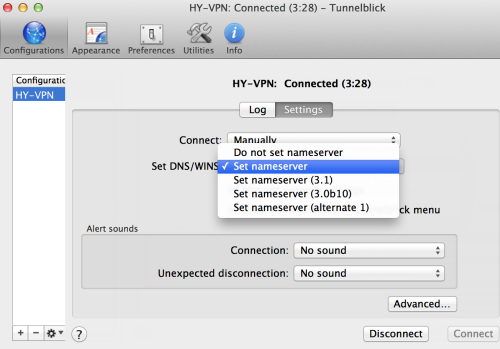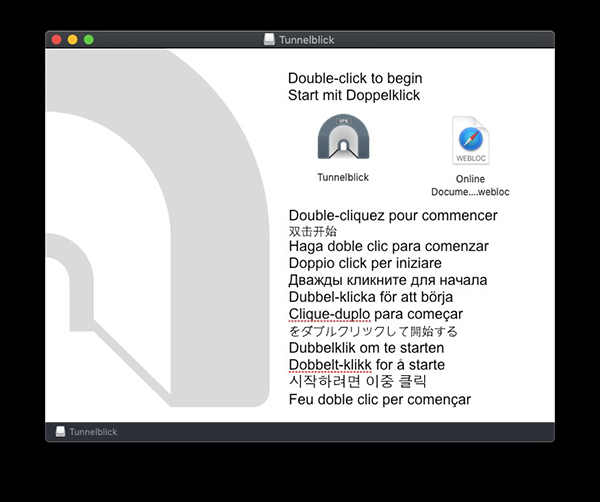
Sophos Tunnelblick Vpn

Tunnelblick Vpn Server
Establish VPN connection. To establish the VPN connection, click on the Tunnelblick icon in the symbol bar at the top right. Select the desired VPN profile from the menu. Now you will be asked for your login credentials. The Tunnelblick application is one of the alternative ways to connect to NordVPN servers on your Mac. This is a good option for those who prefer a manual connection and like tinkering with open-source software. That said, it lacks the additional features of the NordVPN native app but still uses the same VPN protocol — OpenVPN.
Highlighted Articles Discussion Group | Important: See The Future of Tun and Tap VPNs on macOS for information about changes to future versions of macOS. If you have an M1 Mac, also see Tunnelblick and Apple Silicon. If you are using macOS Big Sur, you should use the latest beta version of Tunnelblick. You should allow Tunnelblick to automatically check for updates on the 'Preferences' panel of Tunnelblick's 'VPN Details' window. Be sure to put a check in 'Check for updates to beta versions'. The following is the current status of issues that have been seen using Tunnelblick on macOS Big Sur. To report an issue, please follow the instructions at Tunnelblick Issues. FIXED in Tunnelblick 3.8.5beta03: Tunnelblick's Tun and Tap system extensions do not load. If your configuration requires a Tun or Tap system extension, connecting to your VPN will fail if an appropriate system extension is not installed.
A future version of macOS will not allow the use of Tunnelblick's system extensions. See The Future of Tun and Tap VPNs on macOS. See Installing System Extensions for detailed instructions on installing Tunnelblick's system extensions. FIXED in Tunnelblick 3.8.5beta03: Tunnelblick disables loading of Tun and Tap system extensions. When running on macOS Big Sur 11.0.1 or later, some versions of Tunnelblick force the settings on Tunnelblick's 'Advanced' settings window to 'never load' system extensions. WON'T FIX: Sidecar does not work when a VPN is connected using Tunnelblick's default for a configuration. (This issue is not specific to Big Sur. It is present in all versions of Sidecar.) Sidecar does not work if IPv6 is disabled. By default, Tunnelblick disables IPv6 while a VPN is connected. This is done to prevent information leaks in common VPN setups (see A Glance through the VPN Looking Glass: IPv6 Leakage and DNS Hijacking in Commercial VPN clients). To fix this problem:
|
Sophos Tunnelblick Vpn
Tunnelblick Vpn Server
Establish VPN connection. To establish the VPN connection, click on the Tunnelblick icon in the symbol bar at the top right. Select the desired VPN profile from the menu. Now you will be asked for your login credentials. The Tunnelblick application is one of the alternative ways to connect to NordVPN servers on your Mac. This is a good option for those who prefer a manual connection and like tinkering with open-source software. That said, it lacks the additional features of the NordVPN native app but still uses the same VPN protocol — OpenVPN.
Highlighted Articles Discussion Group | Important: See The Future of Tun and Tap VPNs on macOS for information about changes to future versions of macOS. If you have an M1 Mac, also see Tunnelblick and Apple Silicon. If you are using macOS Big Sur, you should use the latest beta version of Tunnelblick. You should allow Tunnelblick to automatically check for updates on the 'Preferences' panel of Tunnelblick's 'VPN Details' window. Be sure to put a check in 'Check for updates to beta versions'. The following is the current status of issues that have been seen using Tunnelblick on macOS Big Sur. To report an issue, please follow the instructions at Tunnelblick Issues. FIXED in Tunnelblick 3.8.5beta03: Tunnelblick's Tun and Tap system extensions do not load. If your configuration requires a Tun or Tap system extension, connecting to your VPN will fail if an appropriate system extension is not installed.
A future version of macOS will not allow the use of Tunnelblick's system extensions. See The Future of Tun and Tap VPNs on macOS. See Installing System Extensions for detailed instructions on installing Tunnelblick's system extensions. FIXED in Tunnelblick 3.8.5beta03: Tunnelblick disables loading of Tun and Tap system extensions. When running on macOS Big Sur 11.0.1 or later, some versions of Tunnelblick force the settings on Tunnelblick's 'Advanced' settings window to 'never load' system extensions. WON'T FIX: Sidecar does not work when a VPN is connected using Tunnelblick's default for a configuration. (This issue is not specific to Big Sur. It is present in all versions of Sidecar.) Sidecar does not work if IPv6 is disabled. By default, Tunnelblick disables IPv6 while a VPN is connected. This is done to prevent information leaks in common VPN setups (see A Glance through the VPN Looking Glass: IPv6 Leakage and DNS Hijacking in Commercial VPN clients). To fix this problem:
|
Tunnelblick Windows Download
Highlighted Articles Discussion Group | To use Tunnelblick you need access to a VPN server — your computer is one end of the tunnel and the VPN server is the other end. The Tunnelblick project does not provide access to VPN servers — we are not 'VPN service providers' There are several ways to get access to a VPN server:
Employer-provided VPN ServersYour employer should supply you with an OpenVPN configuration file (.ovpn or .conf file), along with the appropriate certificate and key files, or with a Tunnelblick VPN Configuration (.tblk), which includes the certificate and key files within it. Follow the instructions from your employer or in Installing Tunnelblick to install Tunnelblick and configurations. Set Up Your Own VPN ServerThis is more complicated. It involves creating your own OpenVPN configuration file and creating your own certificate and key files for encryption. There are tutorials about setting up OpenVPN servers — try searching the Internet for 'set up openvpn server'. Tunnelblick includes 'easy-rsa' to help you with creating certificate and key files; there is an 'Open easy-rsa in Terminal' button on the Utilities panel. Instructions on using easy-rsa to create encryption files are available in the OpenVPN FAQ. If you want to set up a computer to act solely as a router/bridge/firewall, consider ZeroShell. Untangle has a free VPN component. If you have a router running DD-WRT, you can use OpenVPN on DD-RT. There is a tutorial. If you want to run an high-performance OpenVPN server 'in the cloud', see Create a Private OpenVPN Service with AWS Client VPN Endpoint [github.com]. If you want to run an OpenVPN server 'in the cloud' which also does ad blocking, take a look at the instructions at Pi-Hole and PiVPN on Google Compute Engine Free Tier with Full Tunnel and Split Tunnel OpenVPN Configurations. (Note that the instructions download and install pi-hole and piVPN by piping from curl to bash. A better practice is to download the install scripts, examine them for problems, and then run the already-examined scripts.) VPN Service ProvidersAnother way to get access to a VPN server is to use a VPN service provider, an organization that makes its VPN servers available (free or for a fee). Some provide you with a customized, and possibly renamed, version of Tunnelblick.
VPN service providers: email webmaster@tunnelblick.net to be listed on this page. Disclaimer: The products, services, and links on this page are not endorsed or recommended by the Tunnelblick project or its developers. This list is offered solely for the convenience of those wishing to use Tunnelblick. |

